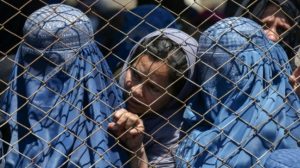It’s happening again, just as predicted. On the heels of the chaotic exodus of U.S. troops from Afghanistan, and despite measures taken to shore up security issues, the Taliban is taking a wrecking ball to human rights, according to credible information from the U.N.
As reported by Reuters, “The U.N. human rights chief said on Tuesday that she had received credible reports of serious violations committed by the Taliban in Afghanistan, including ‘summary executions’ of civilians and Afghan security forces who have surrendered.” And it should come as no surprise that women are the primary target of hostility, aggression, and retribution.
In a special session coordinated by Pakistan, Michelle Bachelet, the head of the Organisation of Islamic Cooperation, warned the UN High Commissioner for Human Rights, “A fundamental red line will be the way the Taliban treat women and girls and respect their rights to freedom, freedom of movement, education, personal expression and employment, in line with international human rights standards.”
Nasir Ahmad Andisha, a former Afghani diplomat, echoed Bacelet’s message, asking the UN body to send “a strong message to all parties, including the Taliban, to make them understand that attacks on human rights will have consequences.”
Unfortunately, if the past is prologue, women in Afghanistan are likely in grave danger, as they fall victim to the tumultuous peaks and valleys of invasions, tribal infighting, reformists efforts, coups and their reprisals, and the oppressive use of Sharia law.
As a recent Bloomberg article points out, “Women’s rights in Afghanistan have been the subject of debate and conflict for more than a century, with efforts to improve their status followed by moves to roll them back. As the country prepares to enter yet another era ruled by the Taliban, rights advocates fear a return to the darkest days of the past.”
The reality is that the advance of women’s rights in Afghanistan has come in fits and starts, as the gains by progressive forces give way to radical fundamentalism or torn asunder by military invasions. In the aftermath of WWI, Amir Amanullah, a reform-minded leader, “crafted a new constitution for Afghanistan that endeavored to guarantee civil rights for all, both men and women.” By outlawing strict traditional dress codes, and having his wife, Queen Soraya set the example by removing her own veil in a very dramatic and public display, Amanullah pushed Afghani society to embrace 20th-century ideals, which were informed by the burgeoning suffragette movement sweeping the globe.
Under his rule, new schools for both boys and girls were opened, the legal age for a woman to marry was raised, forced marriages were banned, and Amanullah even endeavored to end the inherently sexist practice of polygamy. With a decidedly futuristic outlook, he declared “Religion does not require women to veil their hands, feet, and faces or enjoin any special type of veil. Tribal custom must not impose itself on the free will of the individual.”
But the progress was short-lived. After a decade of reforms to lift up the women of Afghanistan, Amanullah was overthrown by a traditionalist revolt, and he was forced into exile. With the installation of Muhammad Nadir Shah, the reforms were rolled back, and once again Afghani women were forced to give up fundamental rights regarding education, marriage, and overall autonomy.
However, the setback was temporary as Shah was assassinated, ushering in another reformist era. Shah, working alongside his brother-in-law, General Mohammed Daud Khan, worked to modernize the economy and cautiously sought to change social conventions of Afghanistan regarding women.
Khan’s “ . . .measures to introduce voluntary unveiling in 1959 had little impact on everyday practice but other reforms—such as introducing women’s right to vote in the 1964 constitution, and promoting women’s right to education and participation in political processes such as loya jirgas—enjoyed more success among women from the middle and upper classes.”
The reforms continued for several decades, until 1978, when the Soviet Marxist Peoples Democratic Party of Afghanistan (PDPA) overthrew Khan in reaction to Khan’s policy of rounding up Marxist dissidents. Aslam Watanjar, one of the military leaders of the rebellion, heralded a new era of collective Communist rule, declaring, “For the first time in history of the empire — the sign of oppression and cruelty — the power of the family of [King] Nadir Khan has ended. All the state power is now in the hands of the people,” adding, unironically, ”The state power is now firmly in the hands of the revolutionary military council.”
And although the Marxist movement promised further liberation of women, the seeds of destruction were already in the making, as internal factions cleaved the fledgling Marxist grass-roots movement (known as the Saur Revolution) and Soviet interest asserted dominance. As Jonathan Neale writes in The Jacobian, “The Communists were split in two. Parcham (the Banner) were more educated, urban, and moderate. Khalk (the People) were less educated, more often from rural families, more often Pashtuns.” Two factions with similar goals of emancipation, but informed by very different kinds of thinking and therefore the means to achieve these goals.
There were also more radical elements in the Khalk faction, which led to a splintering of this group. Over time, under pressure from traditional elements within the Khalk and the more imperialist elements of the Soviet empire, the pursuit of expanded rights for women began to decline. The outcome, as Neale states, “ . . . was also a betrayal of the shared dream of a modern Afghanistan and an end to sexism and grinding poverty.”
When the Soviet military invaded Afghanistan in 1979, the Saur Revolution and its unrealized promise for gender equality ended, giving way to a new era of human rights violations in general, and suppression of women’s rights in particular, as the Soviet military perpetrated planned massacres against the Afghani populace in an attempt to assert complete domination.
The most well-known of the Soviet massacres was when the Soviet army slaughtered around 1,000 people in Laghman Province, killing men, women, and even children. The following account is merely one grim picture of the terror wrought on women by the Soviets:
“From Kabul to Laghman to Kama, the red army also carried out industrial-scale rape on the women of Afghanistan whose only crime was being Afghan and possibly the wife of a fighter in one of the groups fighting the communist regime and occupiers. The rape of Afghan women by the Soviet troops also was aimed to bring shame and dishonor on the family of the woman who was raped. Shattering the religious, racial, and cultural pride was something the reds had sought on Afghanistan, the way they succeeded against the Germans.”
In response to the Soviet aggression, the United States decided to arm the resistance group, known as the Mujahideen. Armed with U.S. military equipment, which was funded by and channeled to the Mujahideen through the CIA-orchestrated Operation Cyclone, the resistance fighters embroiled the Soviets in a drawn-out war, one which eventually led to Soviet capitulation in February of 1989. Mired in postwar poverty and strife, Afghanistan sank into chaos, and women once again became targets of oppression and violence.
Scott Levi, Associate Professor of Islamic Central Asian history at Ohio State University and a founding member of the American Institute of Afghanistan Studies observes: “For Afghan women, this was the beginning of the worst period. The populist warlords used any measure available to appeal to the majority of their soldiers, and the treatment of Afghan women was placed in the hands of poorly educated, rural traditionalists. During the Afghan civil war there was little in terms of the rule of law: men died in large numbers, widows were reduced to begging, rape was commonplace, and suicide among despondent women became ever more frequent.”
Ultimately, the Taliban emerged as a dominant force in Afghanistan in 1994, and a new barbarism against women took shape. Under Taliban rule, women were stripped of all their rights and subjected to unspeakable acts of horror.
As President W. George Bush remarked to the Warsaw Conference on Combating Terrorism, on November 6, 2001: “Women are imprisoned in their homes, and are denied access to basic health care and education. Food sent to help starving people is stolen by their leaders. The religious monuments of other faiths are destroyed. Children are forbidden to fly kites, or sing songs… A girl of seven is beaten for wearing white shoes.”
This systematic oppression went on for seven years, ending only when the United States and our allies invaded Afghanistan and toppled the Taliban, who they argued were harboring and protecting Al-Qaeda, the group responsible for the horrific terrorist attack perpetrated on September 11, 2001. And although there were many struggles and setbacks involving corruption, Afghani women made great strides in regaining autonomy.

Source: naveenbharat.in
Humaira Saqeb, writing for Free Women Writers, argues, “Compared to the Taliban regime, Afghan women’s lives are considerably better. The agenda to increase women’s rights has been more or less supported by the government during the last ten years and the international community has spent millions of dollars on this issue . . .”
But now, with an August 31st deadline looming for the complete withdrawal of U.S forces from Afghanistan, all of the progress that has been made over the past 20 years is about to be undone. Despite the utterance of Zabihullah Mujahid, a spokesman for the Taliban who said women “are going to be working shoulder to shoulder with us. We would like to assure the international community that there will be no discrimination,” the international community, especially human and women rights groups, are skeptical.

Fawzia Koofi, a women’s rights activist, former lawmaker and member of the Afghan delegation that was working to negotiate peace with the Taliban before the U.S. military’s withdrawal, had this warning: “Women in Afghanistan are the most at danger or most at-risk population of the country.” The reports rolling in paint a sobering reality that Koofi is right. As NPR states: “There have already been reports of Afghan women being forced to marry fighters and being publicly flogged. In Herat, female members of parliament had their houses searched and their cars taken away.”
The harsh reality is that the future of Afghani women is future of Afghanistan. The way forward through the pain, degradation, and chaos of the past is dependent on the treatment of Afghani women in the present.
As Roya Rahmani, a women’s activist who arrived in 2018 as Afghanistan’s first female ambassador to the US so eloquently puts it, “In other words, the future of the women of Afghanistan is the future of Afghanistan. If that is going in the right direction, the country is going in the right direction. If that is compromised, oppressed, violated, then so is Afghanistan.” As one Afghani University student evacuated to Qatar who wished to remain anonymous out of fear shared, “We are going back to darkness.”
It is this growing darkness that threatens our global sense of justice. Perhaps ironically, the Talmud, the central text of Rabbinic Judaism, teaches us that “He who saves a single life, saves the world entire.” This life is the collective body of women who comprise the future of not only Afghanistan but inherently the totality of humankind as well. Their future is our future, their plight is our plight, and if they enter darkness, we too shall be consumed by it.
At Newsweed.com, we adhere to three simple principles: truth, balance, and relatability. Our articles, podcasts, and videos strive to present content in an accurate, fair, yet compelling and timely manner. We avoid pushing personal or ideological agendas because our only agenda is creating quality content for our audience, whom we are here to serve. That is why our motto is ”Rolling with the times, straining for the truth.”
Your opinion matters. Please share your thoughts in our survey so that Newsweed can better serve you.
Charles Bukowski, the Los Angeles beat poet that captured the depravity of American urban life once said, “There is something about writing poetry that brings a man close to the cliff’s edge.” Newsweed is proud to stand in solidarity and offer you a chance to get close to the cliff’s edge with our first Power of Poetry Contest. Are you a budding bard, a versatile versifier, a rhyming regaler? Do you march to the beat of iambic pentameter, or flow like a river with free verse? If so, here’s your opportunity to put your mad poetic chops to the test. Enter our poetry contest for bragging rights and an opportunity to win some cash!






